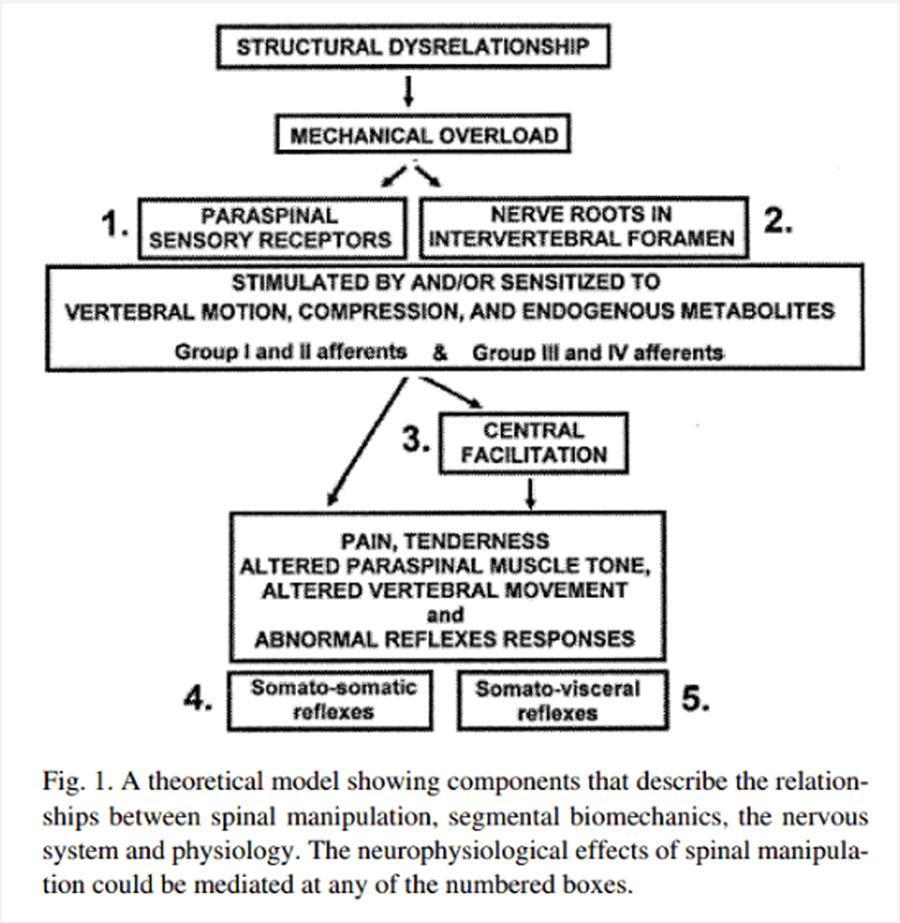Mechanisms of Chiropractic Spinal Manipulative Therapy for Patients with Chronic Primary Low Back Pain: Protocol for a Mechanistic Randomized Placebo-controlled Trial
SOURCE: BMJ Open 2023 (Feb 10); 13 (2): e065999
| OPEN ACCESS |
Carlos Gevers-Montoro, Arantxa Ortega-De Mues, Mathieu Piché
Real Centro Universitario Escorial Maria Cristina,
San Lorenzo de El Escorial, Spain.

Introduction: Chronic low back pain (CLBP) is a highly prevalent and disabling condition. Identifying subgroups of patients afflicted with CLBP is a current research priority, for which a classification system based on pain mechanisms was proposed. Spinal manipulative therapy (SMT) is recommended for the management of CLBP. Yet, little data are available regarding its mechanisms of action, making it difficult to match this intervention to the patients who may benefit the most. It was suggested that SMT may influence mechanisms associated with central sensitisation. Therefore, classifying patients with CLBP according to central sensitisation mechanisms may help predict their response to SMT.
Methods and analysis: This protocol describes a randomised placebo-controlled trial aiming to examine which variables linked to central sensitisation may help predict the clinical response to SMT in a cohort of patients with CLBP. One hundred patients with chronic primary low back pain will be randomised to receive 12 sessions of SMT or placebo SMT over a 4–week period. Pain intensity and disability will be assessed as primary outcomes after completing the 4–week treatment (primary endpoint), and at 4–week and 12–week follow-ups. Baseline values of two pain questionnaires, lumbar pressure pain thresholds, concentrations of an inflammatory cytokine and expectations of pain relief will be entered as predictors of the response to SMT in a multiple regression model. Changes in these variables after treatment will be used in a second multiple regression model. The reference values of these predictors will be measured from 50 age and sex-matched healthy controls to allow interpretation of values in patients. Mixed analyses of variance will also be conducted to compare the primary outcomes and the predictors between groups (SMT vs placebo) over time (baseline vs post-treatment).
There is more like this @ our:
LOW BACK PAIN Section and the:
Ethics and dissemination: Ethical approval was granted by the Fundación Jiménez Díaz Clinical Research Ethics Committee.
Trial registration number: Registered at ClinicalTrials.gov @: NCT05162924.
Keywords: Back pain; COMPLEMENTARY MEDICINE; Clinical trials; IMMUNOLOGY.
From the FULL TEXT Article:
Introduction
Low back pain (LBP) is the single most important cause of disability globally, [1] with a high proportion of patients whose pain persists or recurs. [1–4] Aiming to identify patient profiles that respond more favourably to specific treatments and their prognosis, recent investigations highlight the importance of identifying subgroups among people with chronic LBP (CLBP). One of the proposed classification systems stratifies patients into specific subgroups according to pain mechanisms (nociceptive, neuropathic or central sensitisation). [5–10] It has been suggested that a large proportion of patients with CLBP presents chronic primary pain, which has been linked to altered nociceptive processing. [11, 12] Among the phenomena that may underlie this aberrant processing, central sensitisation (CS) is likely the predominant mechanism, [12, 13] and its involvement in CLBP deserves further research. [14]






Leave A Comment